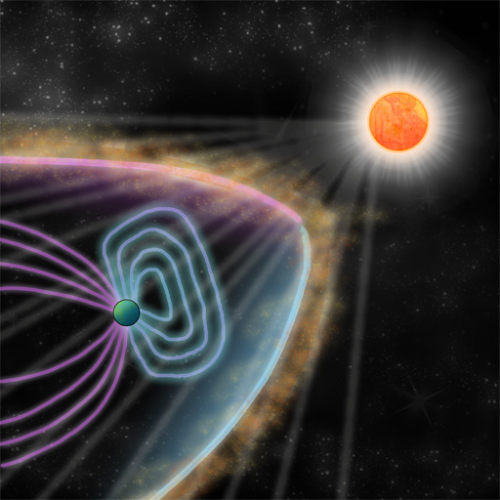In this series, we are taking a look at some of the largest solar storms and examining how they affected our societies at the time. Having kicked off with the Carrington event, let us now move to 1989 and review the impacts that space weather posed on the power industry.
Under normal conditions, the Earth's geomagnetic field is rather effective in protecting the Earth from charged particles from space. However, when the solar wind pushes particularly hard, a significant amount of energy could be transferred over to the magnetosphere surrounding our planet (Figure 1).

| Figure 1 | Illustration of the magnetosphere (Credit: Connie Koo) |
The resulting fluctuations in the Earth's magnetic field are able to give rise to geomagnetically-induced currents (GICs) in conductors on ground level through electromagnetic induction. With the oceans providing a vast conducting surface, these large GICs do not necessarily have to be induced on the power lines themselves, but could enter coastal electrical infrastructures from the sea and drastically increase the load on the grid system.
1989: Quebec Blackout
Following a solar storm in 1989, GICs saturated the transformers at several substations in the Canadian province of Quebec. The protection system was immediately activated and it automatically shut down the associated compensators, which were essential for voltage control. The grid then became so unstable that transmission networks collapsed one by one, leaving 6 million Quebecers without electricity for 9 hours.
Across the border in New Jersey in the U.S., GICs also brought transformers to saturation but the damage was not known until seven days after! While the protection alarm was triggered many times, the disturbance was not serious enough to result in a trip. A routine check of the generator later revealed that the cumulative heating had melted the transformer windings (Figure 2).
In view of these incidents, certain power utilities have implemented preventive measures, such as reducing the power output at the onset of geomagnetic disturbances. It is therefore important for power operators to pay due attention to space weather warnings, and take precautionary actions against the threats posed by extreme solar activities.

| Figure 2 |
Transformer damage at the Salem nuclear plant. Excess energy from the GICs created localised hot spots and caused the copper windings to melt. The device was removed from service in the subsequent inspection, and replacement power was bought from neighbouring utilities for around CA$17 million (HK$130 million), far more than the cost of the transformer itself. (Credit: Public Service Electric and Gas and Peter Balma) |
